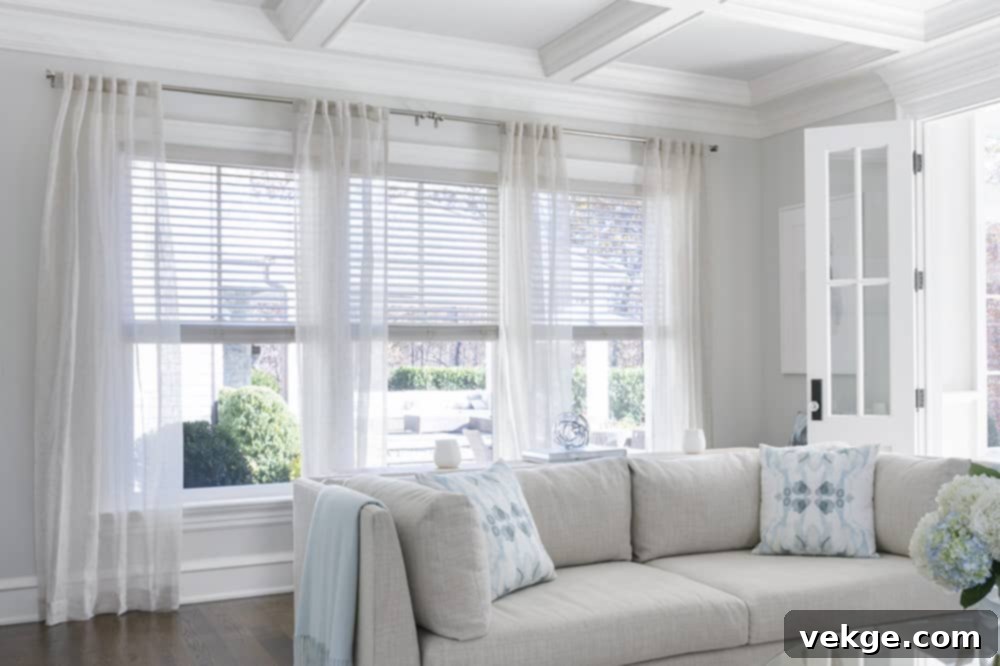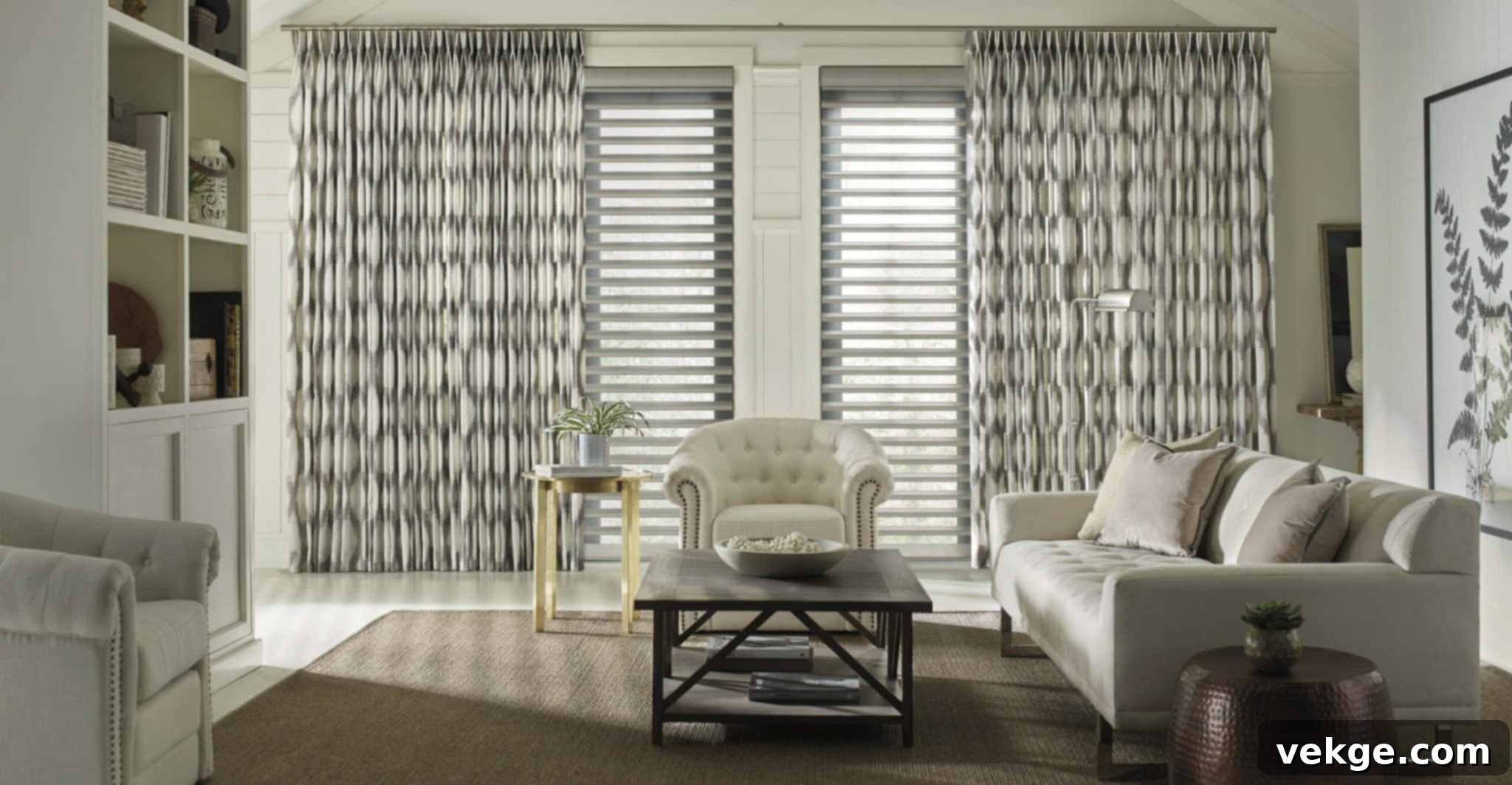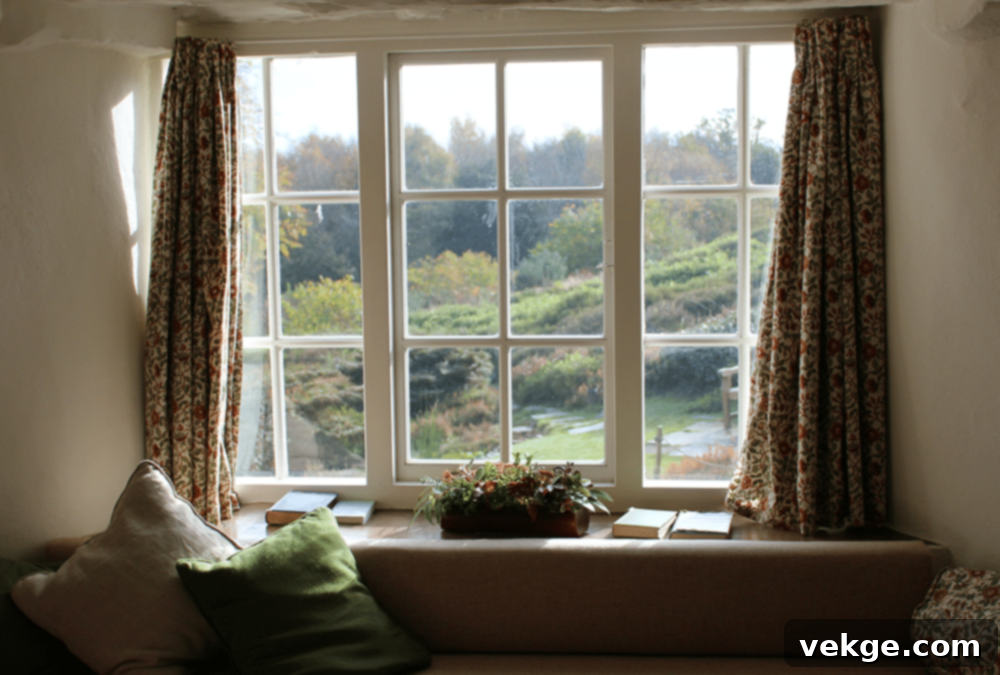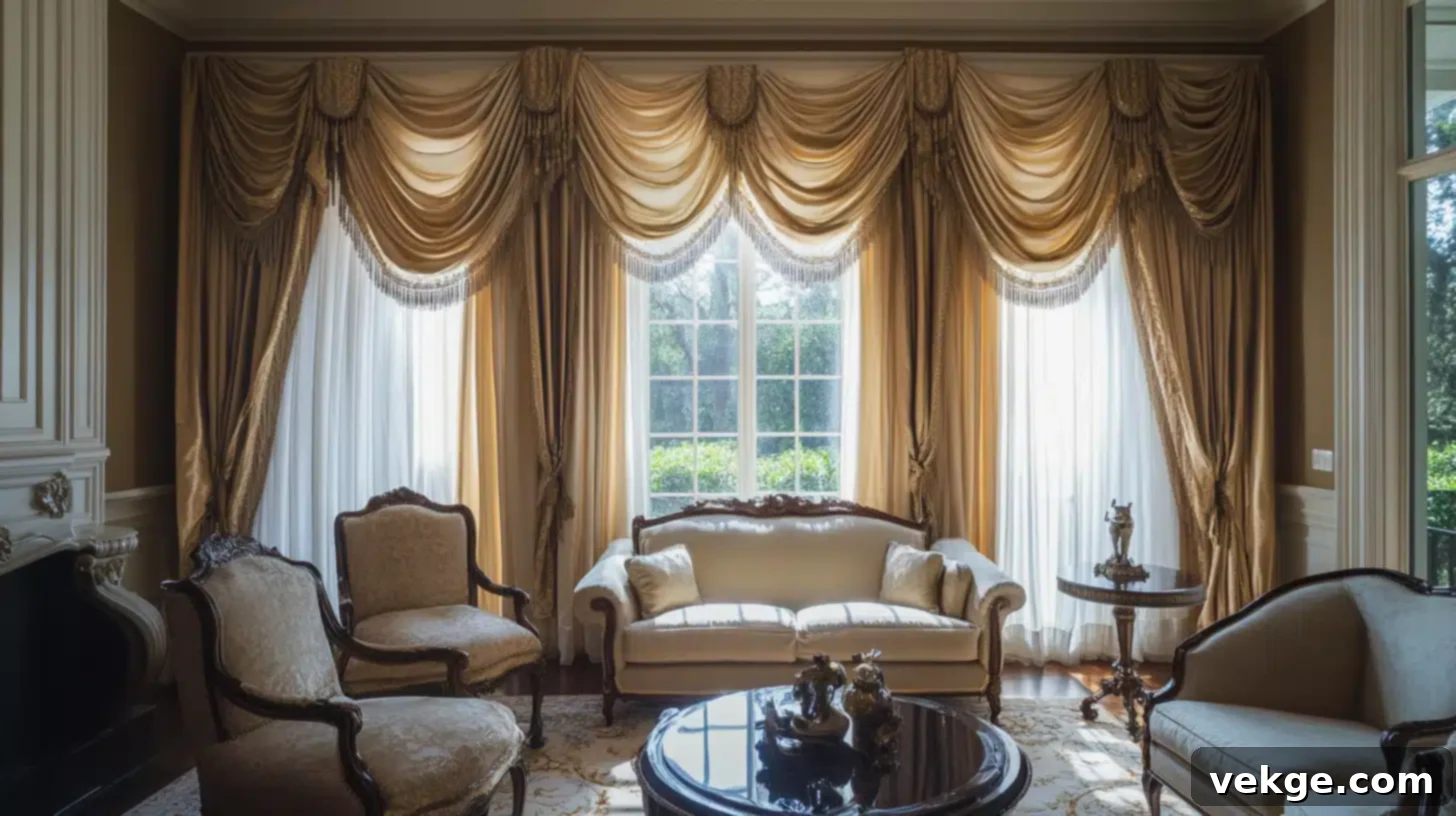Elevate Your Space: A Comprehensive Guide to Custom Curtains & Drapes for Style and Function
Choosing the right custom curtains and drapes is paramount for enhancing both the aesthetic appeal and practical functionality of your home. These versatile window treatments play a pivotal role in defining a room’s character, controlling light, ensuring privacy, and even contributing to energy efficiency. This comprehensive guide will meticulously explore the nuances of selecting, purchasing, and maintaining custom curtains and drapes that not only complement your living space but also address a multitude of practical needs.
By understanding the fundamental differences, considering key design elements, and evaluating functional aspects, you can transform any room into a beautifully appointed, comfortable, and highly personalized environment. Let’s delve into how to make informed decisions that bring your vision to life.
Understanding the Basics of Custom Drapes and Curtains

Difference between Drapes and Curtains
While often used interchangeably, drapes and curtains possess distinct characteristics that serve different purposes and create varied aesthetics in home decor. Curtains are generally lighter, unlined fabric panels that offer a more casual, airy feel. They come in a wide range of opacities, from sheer fabrics that softly filter natural light to semi-opaque options that provide moderate privacy. Curtains are excellent for adding softness, color, and texture without completely blocking views or light.
Drapes, on the other hand, are typically made from heavier, often lined fabrics, giving them a more formal and structured appearance. The lining adds significant benefits, including superior light-blocking capabilities (especially with blackout linings), enhanced insulation against temperature fluctuations, and increased durability. Drapes are ideal for bedrooms, media rooms, or any space where significant light control, privacy, and a luxurious feel are desired. Understanding this core difference is the first step in choosing the perfect custom window treatment for your specific needs.
Types of Materials Used in Custom Window Treatments
The material of your custom drapes or curtains significantly defines not only their visual appeal but also their functionality and longevity. A wide array of fabrics offers different textures, light control, and care requirements:
- Velvet and Suede: These luxurious materials provide a rich, opulent texture and offer excellent light-blocking and insulating properties, perfect for a formal or cozy setting.
- Linen: Known for its natural, relaxed aesthetic, linen offers a breezy, light feel. It allows for diffused light, creating a soft ambiance, though it can wrinkle easily.
- Cotton: A versatile and widely popular choice, cotton is durable, easy to clean, and comes in various weights and weaves. It can be casual or formal, depending on the finish and pattern.
- Silk and Faux Silk: Silk adds an elegant, shimmering touch, ideal for formal spaces. Faux silk provides a similar luxurious look with added durability and easier maintenance, often at a lower cost.
- Sheers: Made from delicate, transparent fabrics like voile or lace, sheers offer minimal privacy but excellent light filtration, creating a soft, ethereal glow. They are often layered under heavier drapes.
- Synthetics (Polyester, Rayon): These man-made fabrics are highly durable, wrinkle-resistant, fade-resistant, and generally more affordable. They can mimic the look of natural fibers and are excellent for high-traffic areas or spaces exposed to direct sunlight.
Importance of Selecting the Right Material
Choosing the right material for your custom curtains is far more than just matching your decor; it’s about aligning with the practical needs, specific function, and overall mood of your space. For instance, in a bedroom, blackout-lined drapes made from a heavier fabric like velvet or a dense cotton blend would be ideal for ensuring maximum light blockage, enhanced privacy, and better sleep quality. In contrast, a living room might benefit from lighter linens or sheer curtains that allow ample natural light to filter through, creating a warm, inviting, and open environment.
Consider factors such as sun exposure (fade resistance), humidity (mold resistance), and the presence of children or pets (durability and ease of cleaning) when making your selection. The material also dictates the drape’s “hand” or how it falls, influencing the overall aesthetic, from crisp and tailored to soft and flowing.
Design Considerations for Custom Window Treatments
Choosing the Right Style for Your Custom Curtains
The style of your curtains or drapes should seamlessly complement the overall design theme of your room, contributing to its character and visual appeal. There are numerous heading styles, each offering a distinct look:
- Rod Pocket: A classic, casual look where the rod slides through a sewn-in pocket.
- Grommet: Modern and sleek, featuring metal rings at the top that slide easily along the rod, creating deep, even folds.
- Tab Top: Loops of fabric at the top create a relaxed, informal vibe.
- Pinch Pleat: A traditional, elegant style with fabric gathered into pleats and secured at the top, offering a structured, tailored appearance.
- Ripple Fold: A contemporary style that creates continuous, soft waves from one end of the track to the other, ideal for a minimalist aesthetic.
Whether you’re aiming for a sleek, modern, minimalist look or a cozy, traditional, maximalist feel, selecting the right curtain style significantly enhances your decor and sets the tone for the entire space.
Matching Custom Curtains with Interior Design Themes
Custom curtains can serve as a stunning focal point or blend seamlessly with the room’s existing decor, depending on your design objectives. When coordinating curtains with your interior design theme, consider key elements like pattern, color, and texture. For a cohesive look, choose colors that are already present in your furniture, rugs, or artwork. Alternatively, for a bold statement, opt for a contrasting color or a striking pattern that “pops” against a more neutral backdrop.
Texture also plays a crucial role; smooth silks or crisp cottons suit modern and formal spaces, while slubby linens or heavy velvets enhance rustic, bohemian, or traditional settings. The key is to maintain balance and harmony within the room’s overall theme, ensuring the window treatments elevate rather than overwhelm the space.
The Impact of Curtain Style on Room Ambiance
Beyond their practical purposes, custom curtains and drapes are powerful tools for setting the mood and ambiance of a room. Light, airy curtains in sheer or semi-sheer fabrics, especially in lighter colors, can make a space feel larger, more open, and brighter, promoting a sense of calm and spaciousness. They are perfect for rooms where you want to maximize natural light and maintain an unobstructed view.
Conversely, heavier drapes made from dense fabrics like velvet or brocade, particularly in darker hues, can create a sense of luxury, warmth, and intimacy. These are ideal for formal dining rooms, master bedrooms, or living spaces where a cozy, enveloping atmosphere is desired. The way the fabric drapes, its pattern, and its color all contribute to the emotional and visual impact, transforming a simple window into a significant design element that profoundly influences the room’s character.
Functional Benefits of Custom Curtains and Drapes

Enhanced Light Control
One of the primary and most appreciated functions of custom curtains and drapes is their ability to precisely manage the amount of natural light entering a room. Different fabrics and linings offer varying levels of light filtration, empowering you to create the perfect ambiance for any time of day or activity. Sheer curtains allow most of the light to pass through, softening harsh rays and maintaining brightness. Semi-sheer or light-filtering curtains diffuse light, reducing glare while still illuminating the room.
For ultimate light control, blackout curtains or drapes with blackout linings can completely block out external light. This is invaluable for bedrooms, nurseries, or home theaters where darkness is essential for sleep enhancement, privacy, or an optimal viewing experience. The choice of fabric opacity allows you to tailor the light exposure to your exact preferences, transforming a bright morning into a restful haven or a sunny afternoon into a cool, shaded retreat.
Superior Privacy
Custom curtains are instrumental in providing essential privacy, especially in residential areas where homes are situated close to each other or for ground-floor windows. Properly selected and hung curtains or drapes can shield your interior from prying eyes without necessarily sacrificing style or natural light. Opaque fabrics, particularly those with liners, offer the highest degree of privacy, ensuring that your personal space remains private day and night.
Even lighter, semi-sheer options can offer a sense of seclusion during the day by blurring outdoor views while still allowing some light to filter in. For rooms where both light and privacy are crucial, layering custom drapes over sheer curtains offers the best of both worlds – the sheers can be closed during the day for light privacy, and the heavier drapes drawn at night for complete seclusion.
Significant Energy Efficiency
Investing in thermal or insulated custom curtains and drapes can lead to substantial energy savings throughout the year. These specialized window treatments are designed with multiple layers of fabric or a specific thermal lining that creates a barrier against external temperatures. In colder months, they help to trap warm air inside, preventing heat loss through windows and reducing the strain on your heating system. During warmer months, they block solar heat gain, keeping your interior cooler and lessening the need for air conditioning.
By minimizing temperature fluctuations, thermal drapes can lower your energy consumption, translate into noticeable reductions in your utility bills, and contribute to a more comfortable indoor climate year-round. This makes them a wise investment for both your wallet and the environment.
Where to Buy Custom Curtains and Drapes
Finding the perfect custom window treatments involves exploring various retail avenues, each offering distinct advantages:
Online Retailers
The internet has become an incredibly popular and convenient resource for buying custom curtains and drapes. Online shops offer an extensive selection, often showcasing a wider variety of styles, fabrics, and patterns than brick-and-mortar stores. This vast inventory allows for competitive pricing and the opportunity to compare numerous options from the comfort of your home. Many online retailers provide detailed product descriptions, high-resolution images, and valuable customer reviews, which can help guide your purchasing decisions. Some even offer free fabric swatches, allowing you to assess color and texture before committing. However, the downside is the inability to physically touch and feel the fabric or see the exact color in your home’s lighting until delivery.
Local Stores and Department Stores
Purchasing from local stores, department stores, or home goods retailers allows you to see and feel the products firsthand. This tactile experience is invaluable for verifying the color, texture, and quality of the material, ensuring it matches your expectations and existing decor. Store associates can also offer personalized advice and answer any immediate questions. While the selection might be more limited compared to online giants, the immediate gratification of taking items home or the ability to return them easily can be a significant benefit.
Custom Design Shops and Boutiques
For those seeking unique, perfectly tailored solutions, custom design shops and specialized boutiques offer unparalleled services. These establishments provide bespoke custom drapes and curtains that are precisely measured and crafted to fit your windows and style preferences. Working with a custom designer ensures an exact fit, access to exclusive fabrics, and expert advice on everything from header style to hardware selection. While this option typically comes with a higher price point, the result is a truly unique, high-quality, and perfectly integrated window treatment that stands out and adds significant value to your home.
How to Measure for Custom Curtains and Drapes

Accurate measurements are the foundation for perfectly fitting custom drapes and curtains. Follow this step-by-step guide carefully to ensure a professional finish:
- Measure Window Width: Begin by measuring the width of your window frame from edge to edge. For optimal coverage and a luxurious look, extend your measurements 6 to 10 inches beyond each side of the window frame. This ensures that the drapes can fully stack back off the window when open, maximizing light, and creating the illusion of a wider window.
- Decide on Fullness: The “fullness” refers to how much extra fabric you want for a gathered or pleated look when the curtains are closed. A general rule of thumb is to choose a curtain width that is 1.5 to 3 times the width of your window (or rod length). For a standard look, 2 to 2.5 times the width is usually recommended for a rich, elegant gather. Sheer curtains often benefit from more fullness (2.5-3x) for a more luxurious ripple.
- Measure Length (Height): Determine your desired curtain length. Measure from the top of where your curtain rod will be placed down to where you want the curtains to end. Common lengths include:
- Sill Length: Ending just above the windowsill (for a crisp, clean look).
- Apron Length: Extending approximately 4-6 inches below the windowsill (a slightly more relaxed look).
- Floor Length: Barely touching the floor (the most popular and elegant choice).
- Puddle Length: Allowing an extra 2-6 inches to pool on the floor, creating a romantic, luxurious effect.
- Consider Rod Placement: For a more expansive and taller room appearance, install the curtain rod 4 to 6 inches (or even higher) above the window frame. This creates an illusion of height and draws the eye upwards, making the window and room feel larger.
- Ensure Sufficient Rod Width: As mentioned in step 1, the curtain rod should ideally extend 6 to 10 inches beyond the window frame on each side. This extra width allows the curtain panels to be pulled entirely off the window glass when open, maximizing natural light and giving the window a more grand appearance.
- Check for Obstructions: Before finalizing your measurements and ordering, carefully note any obstacles such as heaters, radiators, deep window sills, or furniture that could affect the curtain placement or how they hang. Adjust your measurements or rod projection accordingly to avoid issues.
- Double Check All Measurements: Always verify all your measurements at least twice before cutting fabric or placing an order. An error in measurement can be costly and frustrating.
Installation Tips for Custom Curtains and Drapes
DIY Installation vs. Professional Help
Installing custom curtains and drapes can certainly be a rewarding DIY project if you possess the right tools, a bit of patience, and some basic handyman skills. Simple curtain styles like rod pocket or grommet curtains hung on a tension rod or basic decorative rod are typically straightforward to install. However, for more complex installations—such as track systems, traversing rods, multiple layers of window treatments, or for achieving perfect alignment across several windows—professional installation might be well worth the extra cost. Professionals have the expertise to handle various wall materials, ensure precise leveling, and provide a flawless, long-lasting finish.
Tools and Equipment Needed for Installation
For a successful DIY installation of custom drapes or curtains, gather the following basic tools and equipment:
- Drill: Essential for pre-drilling holes for brackets.
- Measuring Tape: For accurate placement of rods and brackets.
- Pencil: To mark drilling spots.
- Level: Crucial for ensuring your curtain rod is perfectly straight.
- Stud Finder: Highly recommended to locate wall studs for secure mounting, especially for heavier drapes.
- Wall Anchors/Toggle Bolts: If mounting into drywall without a stud, these provide necessary support.
- Screwdriver: For tightening screws.
- Step Ladder: To safely reach higher windows.
- Curtain Rods, Brackets, and Finials: Chosen to complement your curtain style and decor.
Always ensure you have the correct fixtures for your specific wall type to prevent damage and ensure the longevity of your installation.
Maintenance and Care for Custom Curtains and Drapes
Cleaning Tips for Longevity
Regular cleaning is essential for extending the life of your custom curtains and drapes and keeping them looking fresh and vibrant. The best cleaning method depends heavily on the fabric type and manufacturer’s instructions. Always check the care label first:
- Vacuuming: Most curtains can be gently vacuumed with an upholstery attachment on a low setting once a month to remove dust and allergens.
- Spot Cleaning: For small stains, dab gently with a damp cloth and mild detergent. Test in an inconspicuous area first.
- Machine Washable: Some cotton or synthetic curtains can be machine washed on a gentle cycle with cold water. Avoid high heat in the dryer to prevent shrinking or damage.
- Dry Clean Only: Delicate fabrics like silk, velvet, or heavily lined drapes often require professional dry cleaning to maintain their shape, color, and texture.
- Steaming: A handheld steamer can effectively remove wrinkles and refresh fabrics without harsh chemicals or washing.
Regular Maintenance Advice
Beyond periodic cleaning, a few simple maintenance habits can significantly prolong the beauty and functionality of your window treatments:
- Regular Dusting: Beyond vacuuming, a gentle shake or a quick wipe with a microfiber cloth can prevent dust buildup.
- Hardware Check: Periodically check and tighten any loose screws on curtain rods, brackets, or finials to ensure stability.
- Even Hanging: Ensure that curtain panels hang correctly and evenly. Adjust any uneven hems or folds to maintain their aesthetic appeal.
- Protect from Sun: Direct, prolonged sunlight can cause fabrics to fade or deteriorate. Consider sheer liners or UV-protective linings to shield your main curtains.
- Address Damage Quickly: Attend to any snags, tears, or stains as soon as they occur to prevent them from becoming larger or more permanent issues.
Trends in Custom Curtain and Drape Designs
Current Trends in Window Treatments
The world of interior design is constantly evolving, and custom curtains and drapes are no exception. Current trends in window treatments lean towards a blend of functionality, sustainability, and sophisticated style:
- Eco-Friendly Materials: A growing demand for sustainable living has led to increased popularity of curtains made from organic cotton, linen, hemp, and recycled polyester.
- Minimalist Styles: Clean lines, subtle textures, and neutral color palettes are favored for modern and contemporary homes, often utilizing ripple fold or grommet headings.
- Layered Treatments: Combining different window treatments, such as sheer curtains under heavier drapes, or pairing blinds with curtains, offers enhanced flexibility in light control, privacy, and adds textural depth.
- Bold Patterns and Colors: While neutrals remain popular, there’s a resurgence of interest in vibrant colors, geometric prints, and large-scale botanical patterns to make a statement.
- Smart Curtains: Integration with smart home systems allows motorized drapes and blinds to be controlled remotely via apps or voice commands, offering convenience and energy efficiency.
Timeless Designs for Enduring Elegance
While trends come and go, some custom curtain and drape designs possess an enduring elegance that remains perennially popular, seamlessly fitting into various decor styles for generations:
- Classic Pinch Pleats: This tailored and sophisticated heading style creates a formal, structured look that never goes out of fashion, suitable for traditional and transitional interiors.
- Solid Neutral Colors: Whites, creams, grays, and soft beige drapes offer a versatile backdrop, allowing other decor elements to shine. They create a serene atmosphere and are incredibly adaptable.
- Linen and Cotton Fabrics: The natural texture and breathable quality of linen and cotton provide a timeless, comfortable, and understated elegance that works in almost any setting, from farmhouse to coastal.
- Velvet Drapes: Synonymous with luxury and warmth, velvet drapes offer a rich texture and excellent light-blocking capabilities, bringing a touch of old-world charm and opulence to a room.
- Floor-Length or Puddled: The timeless appeal of drapes that gracefully touch or lightly puddle on the floor creates a sense of height and grandeur that always looks polished and inviting.
Investing in these timeless designs ensures your window treatments will remain stylish and functional for years to come, transcending fleeting fads.
Customer Stories and Success Cases
Real-life examples often serve as the best inspiration and powerfully demonstrate the transformative potential of well-chosen window treatments. This section would typically feature stories from individuals who have significantly enhanced their living spaces through thoughtfully selected and professionally installed custom drapes and curtains. These narratives often highlight how the right window treatments solved practical challenges—like improving sleep quality with blackout drapes, reducing energy bills with insulated fabrics, or adding much-needed privacy—while simultaneously elevating the overall aesthetic and emotional comfort of their homes. Imagining these stories can help you envision the possibilities for your own space.
Conclusion
Choosing the right custom drapes and curtains is far more than a simple aesthetic decision; it’s a strategic investment in creating a comfortable, functional, and visually appealing environment in your home. By understanding the fundamental differences between drapes and curtains, carefully considering your design options, and knowing where to shop for quality products, you can make informed choices that truly reflect your personal style and meet your specific needs.
From controlling natural light and enhancing privacy to boosting energy efficiency and setting the perfect ambiance, custom window treatments offer a myriad of benefits. With the guidance provided in this comprehensive guide, you are now equipped to select, measure, install, and maintain the perfect custom curtains and drapes that will elevate your living space for years to come.
Frequently Asked Questions About Custom Curtains and Drapes
What is the best fabric for custom curtains?
The “best” fabric depends on your specific needs and the room’s function. For durability and versatility, cotton and linen are excellent choices. Silk and velvet offer a luxurious aesthetic and better insulation but require more delicate care. Polyester blends provide durability, fade resistance, and ease of maintenance. Consider light control, insulation needs, and the overall look you want to achieve when selecting.
How often should I replace my drapes and curtains?
The lifespan of drapes and curtains can vary, but generally, they should be considered for replacement every 5 to 7 years. Signs that they need replacing include significant fading from sun exposure, fraying edges, tears, or if they no longer complement your room’s updated decor. High-quality custom drapes, with proper care, can often last longer.
Can custom drapes improve energy efficiency?
Absolutely. Custom drapes, especially those made from insulating materials or featuring thermal linings, can significantly improve your home’s energy efficiency. They create a barrier against heat transfer through windows, helping to keep rooms warmer in winter and cooler in summer. This can lead to noticeable reductions in your heating and cooling costs.
What are the latest trends in curtain designs?
Current trends emphasize sustainability with eco-friendly fabrics, minimalist aesthetics with clean lines and neutral tones, and smart home integration with motorized systems. Layered window treatments (e.g., drapes over sheer curtains) and a resurgence of bold patterns and colors are also gaining popularity for adding personality and depth to spaces.
How do I choose between drapes and curtains for my space?
To choose between drapes and curtains, consider the room’s primary function, your desired level of light blocking, and thermal insulation needs. Drapes, with their heavier, often lined fabrics, are ideal for maximum privacy, superior light control (e.g., blackout), and enhanced insulation in bedrooms or media rooms. Curtains, being lighter and often unlined, are better suited for spaces where you desire a softer, airier feel, diffused light, and a less formal ambiance, such as living rooms or kitchens.
